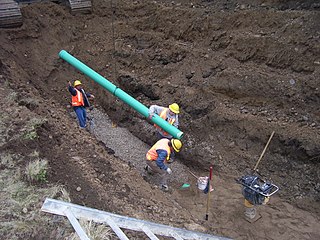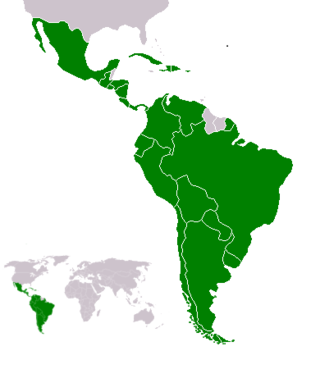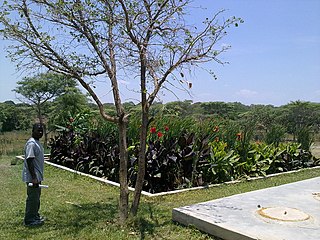Related Research Articles

Sanitation refers to public health conditions related to clean drinking water and treatment and disposal of human excreta and sewage. Preventing human contact with feces is part of sanitation, as is hand washing with soap. Sanitation systems aim to protect human health by providing a clean environment that will stop the transmission of disease, especially through the fecal–oral route. For example, diarrhea, a main cause of malnutrition and stunted growth in children, can be reduced through adequate sanitation. There are many other diseases which are easily transmitted in communities that have low levels of sanitation, such as ascariasis, cholera, hepatitis, polio, schistosomiasis, and trachoma, to name just a few.

Sewerage is the infrastructure that conveys sewage or surface runoff using sewers. It encompasses components such as receiving drains, manholes, pumping stations, storm overflows, and screening chambers of the combined sewer or sanitary sewer. Sewerage ends at the entry to a sewage treatment plant or at the point of discharge into the environment. It is the system of pipes, chambers, manholes, etc. that conveys the sewage or storm water.

A sanitary sewer is an underground pipe or tunnel system for transporting sewage from houses and commercial buildings to a sewage treatment plant or disposal. Sanitary sewers are a type of gravity sewer and are part of an overall system called a "sewage system" or sewerage. Sanitary sewers serving industrial areas may also carry industrial wastewater. In municipalities served by sanitary sewers, separate storm drains may convey surface runoff directly to surface waters. An advantage of sanitary sewer systems is that they avoid combined sewer overflows. Sanitary sewers are typically much smaller in diameter than combined sewers which also transport urban runoff. Backups of raw sewage can occur if excessive stormwater inflow or groundwater infiltration occurs due to leaking joints, defective pipes etc. in aging infrastructure.

Water supply and sanitation in Latin America is characterized by insufficient access and in many cases by poor service quality, with detrimental impacts on public health. Water and sanitation services are provided by a vast array of mostly local service providers under an often fragmented policy and regulatory framework. Financing of water and sanitation remains a serious challenge.
Slum networking is a holistic approach for improving urban infrastructure, developed by Himanshu Parikh
Guyana, meaning "land of many waters", is rich in water resources. Most of the population is concentrated in the coastal plain, much of which is below sea level and is protected by a series of sea walls. A series of shallow reservoirs inland of the coastal plain, called "water conservancies", store surface water primarily for irrigation needs. Key issues in the water and sanitation sector in Guyana are poor service quality, a low level of cost recovery and low levels of access.
Access to at least basic water increased from 94% to 97% between 2000 and 2015; an increase in access to at least basic sanitation from 73% to 86% in the same period;
Drinking water supply and sanitation coverage in Honduras has increased significantly in the last decades. However, the sector is still characterized by poor service quality and poor efficiency in many places. Coverage gaps still remain, particularly in rural areas.

Drinking water supply and sanitation in Argentina is characterized by relatively low tariffs, mostly reasonable service quality, low levels of metering and high levels of consumption for those with access to services. At the same time, according to the WHO, 21% of the total population remains without access to house connections and 52% of the urban population do not have access to sewerage. The responsibility for operating and maintaining water and sanitation services rests with 19 provincial water and sewer companies, more than 100 municipalities and more than 950 cooperatives, the latter operating primarily in small towns. Among the largest water and sewer companies are Agua y Saneamientos Argentinos (AYSA) and Aguas Bonarenses S.A. (ABSA), both operating in Greater Buenos Aires, Aguas Provinciales de Santa Fe, and Aguas Cordobesas SA, all of them now publicly owned. In 2008 there were still a few private concessions, such as Aguas de Salta SA, which is majority-owned by Argentine investors, and Obras Sanitarias de Mendoza (OSM).
The water and sanitation sector in Peru has made important advances in the last two decades, including the increase of water coverage from 30% to 85% between 1980 and 2010. Sanitation coverage has also increased from 9% to 37% from 1985 to 2010 in rural areas. Advances have also been achieved concerning the disinfection of drinking water and in sewage treatment. Nevertheless, many challenges remain, such as:
Costa Rica has made significant progress in the past decade in expanding access to water supply and sanitation, but the sector faces key challenges in low sanitation connections, poor service quality, and low cost recovery.
Water supply and sanitation in Indonesia is characterized by poor levels of access and service quality. Almost 30 million people lack access to an improved water source and more than 70 million of the country's 264 million population has no access to improved sanitation. Only about 2% of people have access to sewerage in urban areas; this is one of the lowest in the world among middle-income countries. Water pollution is widespread on Bali and Java. Women in Jakarta report spending US$11 per month on boiling water, implying a significant burden for the poor.
India faces challenges ranging from sourcing water for its megacities to its distribution network which is largely intermittent with continuous distribution networks just beginning to emerge. Non-revenue water is a challenge.

Simplified sewerage, also called small-bore sewerage, is a sewer system that collects all household wastewater in small-diameter pipes laid at fairly flat gradients. Simplified sewers are laid in the front yard or under the pavement (sidewalk) or - if feasible - inside the back yard, rather than in the centre of the road as with conventional sewerage. It is suitable for existing unplanned low-income areas, as well as new housing estates with a regular layout. It allows for a more flexible design. With simplified sewerage it is crucial to have management arrangements in place to remove blockages, which are more frequent than with conventional sewers. It has been estimated that simplified sewerage reduces investment costs by up to 50% compared to conventional sewerage.
The Philippines' water supply system dates back to 1946, after the country declared independence. Government agencies, local institutions, non-government organizations, and other corporations are primarily in charge of the operation and administration of water supply and sanitation in the country.

Water supply and sanitation in Kenya is characterised by low levels of access to water and sanitation, in particular in urban slums and in rural areas, as well as poor service quality in the form of intermittent water supply. Seasonal and regional water scarcity in Kenya exacerbates the difficulty to improve water supply.
Water supply and sanitation in Japan is characterized by numerous achievements and some challenges. The country has achieved universal access to water supply and sanitation; has one of the lowest levels of water distribution losses in the world; regularly exceeds its own strict standards for the quality of drinking water and treated waste water; uses an effective national system of performance benchmarking for water and sanitation utilities; makes extensive use of both advanced and appropriate technologies such as the jōkasō on-site sanitation system; and has pioneered the payment for ecosystem services before the term was even coined internationally. Some of the challenges are a decreasing population, declining investment, fiscal constraints, ageing facilities, an ageing workforce, a fragmentation of service provision among thousands of municipal utilities, and the vulnerability of parts of the country to droughts that are expected to become more frequent due to climate change.
Water supply and sanitation in Nairobi is characterised by achievements and challenges. Among the achievements is the expansion of infrastructure to keep pace with population growth, in particular through the construction of the Thika Dam and associated water treatment plant and pipelines during the 1990s; the transformation of the municipal water department into an autonomous utility in 2003; and the more recent reduction of water losses – technically called non-revenue water – from 50 to 40%.
Water supply and sanitation in Vietnam is characterized by challenges and achievements. Among the achievements is a substantial increase in access to water supply and sanitation between 1990 and 2010, nearly universal metering, and increased investment in wastewater treatment since 2007. Among the challenges are continued widespread water pollution, poor service quality, low access to improved sanitation in rural areas, poor sustainability of rural water systems, insufficient cost recovery for urban sanitation, and the declining availability of foreign grant and soft loan funding as the Vietnamese economy grows and donors shift to loan financing. The government also promotes increased cost recovery through tariff revenues and has created autonomous water utilities at the provincial level, but the policy has had mixed success as tariff levels remain low and some utilities have engaged in activities outside their mandate.

Decentralized wastewater systems convey, treat and dispose or reuse wastewater from small and low-density communities, buildings and dwellings in remote areas, individual public or private properties. Wastewater flow is generated when appropriate water supply is available within the buildings or close to them.
References
- ↑ "Brief History of Sewers in the Ancient World" . Retrieved 2023-05-01.
- 1 2 "Esgoto Condominial" (in Portuguese). Companhia de Saneamento Ambiental do Distrito Federal.
- ↑ 2014 (retrieval date), World Health Organization, Sanitation challenge: Turning commitment into reality, Accessed June 9, 2014, "...condominial sewers in Latin America... In Brazil, an alternative approach was developed more than 20 years ago and is now adopted as standard in many cities and towns. Condominial approaches are cheaper to build and operate than conventional systems..."
- ↑ Anurodh Lalit Jain, April 29, 2012, The Hindu, Breaking the sanitation taboo, Accessed June 9, 2014, "...Brazil developed a condominial approach or simplified sewerage to construct water and sewerage networks ... Condominial sewerage is a low-cost sewer system that emphasises on community participation in planning and the maintenance of sewer system at the block level. Brazil quickly operationalised a 1,200-km network of condominial sewers, the largest example of simplified sewerage in the world...."